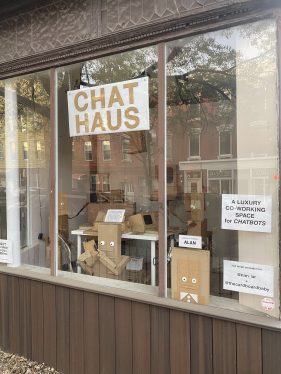AI Artistry: The Absurdity of Chatbots in Cardboard Co-Working Spaces

In a quirky display of creativity, Brooklyn’s unique art installation, known as Chat Haus, redefines the concept of a “coworking space” for artificial intelligence (AI) chatbots. Positioned strategically between a local school and a library, this temporary exhibit humors the evolving role of AI in our everyday lives while echoing the underlying frustrations of professionals transitioning into this new era.
Instead of the usual office splendor, Chat Haus is entirely crafted from cardboard, featuring lifelike cardboard robots engaging in simulated work tasks via small motors. This imaginative project by artist Nim Ben-Reuven serves as both a critique and commentary on the impact of AI on creative industries, specifically how it is disrupting traditional roles in graphic design and videography.
“Chat Haus is a metaphor for the fraying state of creativity and how AI tools are taking over jobs that many individuals have long relied on,” Ben-Reuven explained. For a monthly fee of $1,999, visitors can theoretically rent a ‘desk’ at this cardboard co-working space, an invitation to poke fun at how seriously we sometimes take our work environments and the invasion of technology in creative fields.
The installation has attracted attention from varied demographics, ranging from preschoolers to millennials, who pause to capture the essence of this odd juxtaposition of technology and traditional craftsmanship. Standing before the display, viewers are invited to consider the implications of AI on human creativity, with Ben-Reuven noting that the volatility of cardboard symbolizes the potential fragility of AI-produced art—often glamorous at first glance but unsustainable under deeper scrutiny.
Moreover, Ben-Reuven reflects on how the input of AI into artistic realms is akin to indulging in junk food—addictive yet devoid of lasting value. This playful critique sheds light on the potential hollowness of quickly generated AI art against the richness of human-created work.
As the Chat Haus continues to draw viewers, Ben-Reuven expresses hope for its longevity, aiming to keep it visible until at least mid-May. He’s also considering expanding the exhibit into a larger venue, should he secure space. Despite the challenges the rise of AI presents, Ben-Reuven maintains a positive stance, believing that art should engage audiences across all age groups and perspectives.
“In the grand scope of global issues, the rise of AI in creativity seems relatively trivial, yet it compels a serious conversation about our future,” he asserted. This vibrant exhibit stands not only as a reflection of current industry shifts but also as a humorous reminder of how we might perceive these changes. For more on AI’s impact on various sectors, readers can explore insights from industry leaders on AI-enhanced creative tools and their applications today.
For further reading on this captivating shifting landscape, see AI tools for creative exploration and the future of AI in workplaces.
